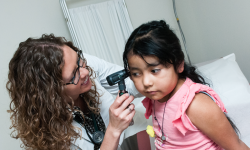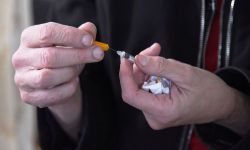Did Michigan health orders slow COVID? Probably. But how much is debatable.

When Michigan’s health director, Robert Gordon, last week announced continued restrictions on some businesses and the relaxation of them on others, he touted continuing decline in case numbers statewide.
Comparing COVID-19 numbers, he pointed out that Ohio’s case counts were substantially higher than those in Michigan, despite being almost identical in late October.
It was proof, Gordon said, that the tough medicine of banning indoor dining and other activities like bowling and movie-going, helped reduce cases, hospitalizations and deaths.
“The pause is working,” he said Friday.
No doubt, Michigan has far lower case counts than Ohio and other neighboring states. But a Bridge Michigan analysis has found the relationship between restrictions and lower cases may be less definitive than Gordon suggested.
It’s a defining question of the year: How much can business restrictions bend the coronavirus curve? Few dispute they do to some extent, but many others question the economic and social cost.
The numbers provide fodder to both backers and skeptics of the restrictions.
Democrats and others point out that Michigan currently has the lowest seven-day average of new daily cases per 1 million of other Great Lakes states.
In the Great Lakes, Gordon and other supporters point out that states with more restrictions have experienced bigger, clearer declines.
“Michigan is clearly in the best position of any state in our region,” he said.
But Republicans and others note that Michigan also has one of the region’s highest jobless rates — and almost every state, including those with fewer restrictions, are also experiencing a decline in cases.
The debate perhaps is best exemplified by the top two states with the highest current rates of infection: Tennessee and California, which both have more than 1,000 new daily infections per 1 million people.
That’s more than double Michigan’s current rate of 451 new daily cases (Tennessee’s is three times higher).
Republican Tennessee has no mask mandate and no ban on indoor dining or bars. Democratic California has all three, and yet hospitals in both states are overwhelmed with COVID-19 patients.
Here’s the trend of Great Lakes states with similar restrictions as Michigan.
And here are trends of states that have no banned indoor dining (although some of their counties may have tougher restrictions):
That raises the question: How much do restrictions, like those on indoor dining, push down case rates?
“That’s the million-dollar question,” said Lindsey Leininger, clinical professor of business administration at the Tuck School of Business at Dartmouth College who specializes in health care, data analytics and public policy. “To attribute cause and effect is a tough thing to do.”
The science behind the bans is clear, Leininger said: Limiting close contact among maskless people from multiple households drastically reduces the virus’ spread.
But she said the impact of restrictions of dining bans is less clear.
That’s because many people, without an edict from the government, have chosen to avoid restaurants, buy groceries online or adopt similar distancing to stay safe.
Take Minnesota and Wisconsin: Minnesota has imposed more restrictions, including a ban on indoor dining. But in neighboring Wisconsin, a court ruling has limited Gov. Tony Evers’ ability to implement similar measures.
Even so, caseloads have remained about the same in both states.
It could take years to identify whether — and how much — government actions affected the spread of the coronavirus, Leininger said.
Scholars will pore over cellphone data, infection rates, state and county-level restrictions and economic indicators to discern which decisions had the most impact.
“These are the kinds of questions we’ll be able to answer later,” she said.
But politicians and the public are arguing about them now. Gordon and Gov. Gretchen Whitmer have highlighted Michigan’s “success” compared to its neighbors.
Others have pointed to the pain suffered by businesses that have been ordered closed.
Michigan Republicans have resisted calls to pass legislation allowing a mask mandate, relying instead on messaging — strong public campaigns encouraging but not mandating safe practices.
“Use targeted actions. Fine tuned messaging. Loud. Consistent. Informing, inspiring, and encouraging,” Senate Majority Leader Mike Shirkey, R-Clarklake, told Bridge Michigan recently. “No more blunt force instruments.”
Related stories
- Michigan health officials wrestling with who will get COVID vaccine next
- Five ethical questions raised by COVID vaccines in Michigan
- Dashboard: Michigan coronavirus testing numbers, trends, COVID-19 data
He said “local businesses can’t inoculate themselves against shutdowns. There are no vaccines for bankruptcy. Enough is enough. Open the economy. Punish the bad actors, but don’t destroy jobs.”
Looking at economic data between states, there are differences: Michigan and Illinois, which have both adopted tougher restrictions, have the highest unemployment rates in the region, at 6.9 percent in November.
But Minnesota, which has also banned indoor dining, has the lowest rate, at 4.4 percent.
Ohio, Wisconsin and Indiana, which have higher rates of new infections than Michigan, also have lower jobless rates: Indiana and Wisconsin at 5 percent and Ohio at 5.7, both over 1 percentage point better than Michigan.
And the economic differences in the top two states for COVID is stark as well. Tennessee, which has few restrictions, had a 5.3 unemployment rate in November, compared to 8.2 percent in California, which has many business restrictions.
Don Grimes, an economist and senior research specialist at the University of Michigan, said states with tougher restrictions typically have higher jobless rates than those that have fewer restrictions.
“There is definitely a tradeoff between restricting activity and the labor market situation,” Grimes wrote in an email. “The question for policy makers is whether or not it's worth it, because of the lives and illnesses saved.”
Earlier this year, Congress added $600 per week to jobless benefits, while a new stimulus plan approved Monday will include another $300 per week for the unemployed.
In Michigan, a $465 million COVID-19 relief package approved this week provides assistance for those whose industries, like restaurants, have been hardest hit by the restrictions. It would include a payment of $1,650 to workers laid off because of state health restrictions.
But Grimes said the impact of restrictions has hit restaurants the hardest, which impacts the state’s jobless rate more than its tax coffers.
Because of the typical lower wages of the industry, restaurants account for about 8 percent of state jobs but less than 3 percent of total wages, he said.
Mask mandates
Most states have mask mandates on indoor activity, with 36 adopting them, including Michigan and all Great Lakes states, and eight not doing so.
For about a month, the Dakotas — both sparsely populated, largely rural states — have had some of the highest case rates of the pandemic. North Dakota has a mask mandate, but South Dakota does not. Neither ban indoor dining and both states are still far higher rates of new infections than Michigan or almost all Great Lakes states — but in both Dakotas those rates are falling rapidly.
Avoiding the plane crash
Shirkey, the Senate majority leader, has said there’s “zero statistical data confirming” that the current restrictions have brought down case counts.
In one sense, he’s right, as Leininger has said it will take time.
But the Dartmouth professor gave government leaders credit for taking proactive measures to lessen infections, sickness and death. She said she tells her students that people want health restrictions to be as precise as guiding a rocket, where every action has a measurable reaction.
“But in reality it’s like a bush pilot in a storm trying to avoid a crash landing with some controls that may or may not work,” Leininger said. “Governors and other leaders [are] trying to do everything not to crash the plane.”
See what new members are saying about why they donated to Bridge Michigan:
- “In order for this information to be accurate and unbiased it must be underwritten by its readers, not by special interests.” - Larry S.
- “Not many other media sources report on the topics Bridge does.” - Susan B.
- “Your journalism is outstanding and rare these days.” - Mark S.
If you want to ensure the future of nonpartisan, nonprofit Michigan journalism, please become a member today. You, too, will be asked why you donated and maybe we'll feature your quote next time!








